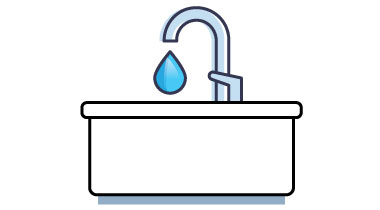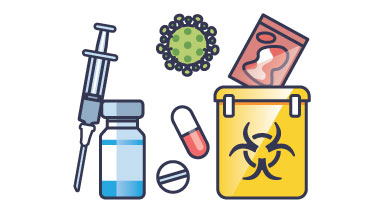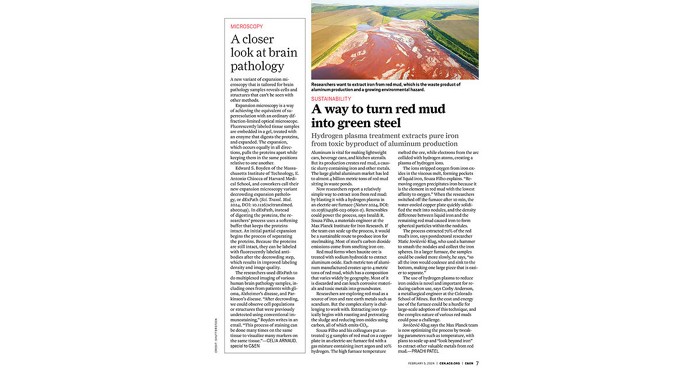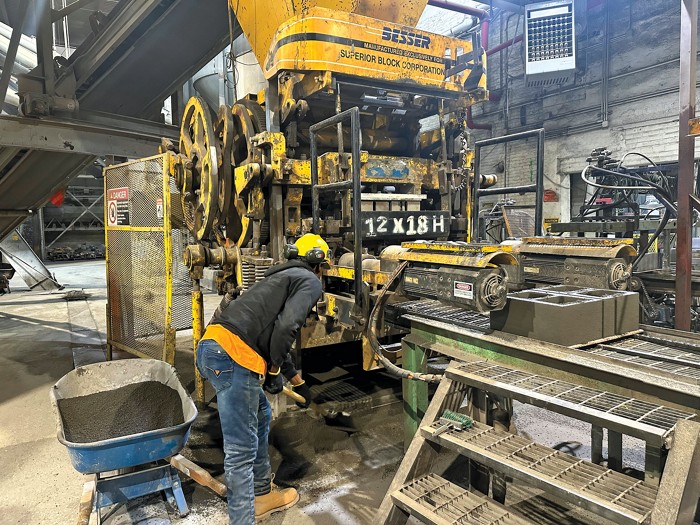Advertisement
Grab your lab coat. Let's get started
Welcome!
Welcome!
Create an account below to get 6 C&EN articles per month, receive newsletters and more - all free.
It seems this is your first time logging in online. Please enter the following information to continue.
As an ACS member you automatically get access to this site. All we need is few more details to create your reading experience.
Not you? Sign in with a different account.
Not you? Sign in with a different account.
ERROR 1
ERROR 1
ERROR 2
ERROR 2
ERROR 2
ERROR 2
ERROR 2
Password and Confirm password must match.
If you have an ACS member number, please enter it here so we can link this account to your membership. (optional)
ERROR 2
ACS values your privacy. By submitting your information, you are gaining access to C&EN and subscribing to our weekly newsletter. We use the information you provide to make your reading experience better, and we will never sell your data to third party members.
Sustainability
How Groningen’s labs are going green
One university’s efforts to make science more sustainable
by Bethany Halford
July 12, 2024
| A version of this story appeared in
Volume 102, Issue 21

Emissions by the numbers
3 metric tons (t) Amount of carbon dioxide emissions per conference attendee traveling via airplane on a 9,500 km average round trip
80,000 t Amount of CO2emissions from a conference with 28,000 scientists attending in person
5–10 Factor by which labs’ energy consumption exceeds that of office buildings of the same size
3.5 Factor by which a single fume hood’s energy consumption exceeds that of an average US household
60% Laboratories’ share of a university’s water use
228 L Amount of water an autoclave can use per cycle
2% Laboratory research’s share of global plastic waste
7 t Annual amount of hazardous chemical waste produced in a 45-person chemistry lab
Sources: RSC Sustainability 2024, DOI: 10.1039/d4su00056k and sources therein.
Over the course of Ben L. Feringa’s long career in the Netherlands as a chemistry professor at the University of Groningen, he has published more than 1,000 papers, trained scores of graduate students and postdoctoral scholars, and even garnered a Nobel Prize in Chemistry. But all that work has also produced something else—a lot of carbon dioxide. Feringa’s efforts have put out as much as 15,258 metric tons (t) of CO2during the course of his 47-year career, according to a back-of-the-envelope calculation. That’s 324 t of CO2annually. A midsize car’s annual CO2emissions, by comparison, is about 2 t.
Feringa and colleagues at Groningen recently published a perspective in the journal RSC Sustainability that examines the researchers’ carbon footprint and their efforts to make their labs more sustainable (2024, DOI: 10.1039/d4su00056k). Looking at all the CO2emitted by the school’s science and engineering departments—accounting for everything from conference-related air travel to waste production—the researchers estimate that for each publication that scientists at Groningen put out, they generate 68 t of CO2.
Feringa says he knew that his lab, which focuses on organic synthesis, generates a lot of waste, particularly solvents. And he knew that his extensive travel—he has received a huge number of invitations to speak around the world since winning the Nobel—was a major source of carbon emissions. But the accounting of his overall energy consumption and associated CO2 emission was eye popping. He was unaware of all the energy costs associated with everyday tasks like filing data, doing basic calculations, and even sending email.
“I feel strongly that we have to advocate for how we will do chemistry in the future,” Feringa says. If chemistry is important for our sustainable future, we should be doing chemistry in a more sustainable way, he says.
The sheer scale of scientists’ impact on the environment is mind blowing, says Michael M. Lerch, an assistant professor at Groningen. Scientists will justify the energy costs associated with their work because it has the potential to do good, he says. But at the same time, this work uses massive amounts of resources and can be astonishingly polluting compared with the environmental footprints of nonscientists across the world. “That is really a sobering realization that more people should have,” Lerch says.
It’s a realization that dawned on Thomas Freese early in his scientific career. For his PhD research in Feringa’s group, Freese was working to make furfural, an important feedstock chemical that can be converted to coatings, from biomass-derived lignocellulose.
“My research was always aiming to make the planet and future better. But at some point, I questioned my own habits or how I got the data,” Freese says. He worried about the solvents and plastics in his day-to-day research activities.
Freese and like-minded colleagues at Groningen decided to start a grassroots movement to make the school’s labs greener. “We were thinking, How we can improve ourselves to not only publish something green but also be green at our workplace? Because this is where we spend 8 hours of the day.” Groningen’s life sciences faculty and chemistry department combined their efforts in 2021 to create Green Labs RUG.
As part of their efforts, the researchers created “A guidebook for sustainability in laboratories,” which exists as a living document on ChemRxiv (DOI: 10.26434/chemrxiv-2023-g3lmq-v4). The goal of the guidebook and the RSC Sustainability perspective is to compile the plethora of data about sustainable practices and present them to the scientific community in an easy-to-access format, Freese and Lerch say.
The labs at Groningen have already made big changes in their electricity consumption. Labs are energy hogs. The amount of electricity that Groningen’s science and engineering facilities uses in 1 h is equivalent to how much electricity the average Dutch family uses in an entire year, according to the Groningen researchers.
Emissions by the numbers

3 metric tons (t)
Amount of carbon dioxide emissions per conference attendee traveling via airplane on an 9,500 km average round trip

80,000 t
Amount of CO2 emissions from a conference with 28,000 scientists attending in person

5–10
Factor by which labs’ energy consumption exceeds that of office buildings of the same size

3.5
Factor by which a single fume hood’s energy consumption exceeds that of an average US household

60%
Laboratories’ share of a university’s water use

228 L
Amount of water an autoclave can use per cycle

2%
Laboratory research’s share of global plastic waste

7 t
Annual amount of hazardous chemical waste produced in a 45-person chemistry lab
Sources: RSC Sustainability 2024, DOI: 10.1039/d4su00056k and sources therein
Credit: Yang H. Ku/C&EN/Shutterstock
The researchers helped cut their energy usage by using fume hoods with sashes that close automatically, raising the temperature of freezers from –80 °C to –70 °C when appropriate, and turning off computers and equipment at the end of the workday. The scientists also shut down their laboratories, turning off all unused equipment, during the school’s 2022–23 winter break. Green Labs RUG estimates this 2-week shutdown alone saved the university around $265,000 in energy costs.
Freese points out that other changes may need support from administrators or might have costs associated with implementing change, but changes to electricity consumption were easy and especially impactful.
One area that the researchers say is ripe for improvement is conference travel. “What surprised me the most is the fact that the traveling of 0.1% of the population—so 8.4 million researchers on the planet—if we all go to one conference per year, and travel by flying, then we are having a bigger carbon footprint than countries such as Uganda,” Freese says. And yet going to conferences rarely comes up in conversations about sustainability.
The researchers say prioritizing local conferences and meetings that are accessible via train travel could cut down on some travel-related carbon emissions. They also suggest that conference organizers coordinate their efforts so that when researchers do have to travel by airplane, they can attend multiple meetings.
Cutting down on plastic and chemical waste can also make a significant impact on sustainability, the scientists with Green Labs RUG say. Teaching labs for undergraduates, which often train more than 100 students at a time, can generate a mountain of plastic waste and a river of used solvents. Considering the impact of the experiments the students are tasked with could go a long way toward making these labs greener, they say. On the research side, Green Labs RUG recommends keeping a schoolwide chemical inventory. This prevents researchers from one group from purchasing chemicals colleagues in a different group may already have.
Martin Farley, associate director of environmental sustainability for UK Research and Innovation, the UK’s flagship science-funding agency, says the RSC Sustainability paper brings green chemistry and sustainable lab practice together in a seamless fashion.
By putting everything in one wider review article, the researchers have made the information accessible for people who want to learn what’s possible to do to make their science more sustainable, Farley says. But, like most work in this area, such reviews need frequent updates.
“We need more work in this space,” Farley says, adding that it’s not just academics who need to be working on sustainable science. Institutions and funding agencies need to make it a priority too.
Kathryn Ramirez-Aguilar, who is manager of the Green Labs Program at the University of Colorado Boulder, agrees that funding agencies need to make it clear that sustainable labs are important. “That will bring widespread, fast change,” she says.
Ramirez-Aguilar points to several funding bodies in Europe that have taken action on this front, including those in Germany, Ireland, and the UK. Until sustainable laboratory practices are a priority for funding agencies elsewhere, she says, progress will likely be slow.
But the work in Groningen shows that sustainable laboratory practices can be adopted quickly, Ramirez-Aguilar says. She’s impressed with the speed at which the efforts at Groningen have come together and thinks this is likely due to the support at all levels across the university—from students to faculty and administrators. “I am excited that green labs actions are being highlighted by such a prestigious scientist—Ben Feringa—and his colleagues,” she says.
And the efforts don’t stop with the science and engineering labs. Freese hopes to expand the sustainable lab efforts to the two hospitals and handful of chemistry companies in Groningen. He envisions a future where every lab in the city is sustainable.
For anyone else who might be interested in bringing such efforts to their lab, he says, “It’s easy to start.”





Join the conversation
Contact the reporter
Submit a Letter to the Editor for publication
Engage with us on Twitter